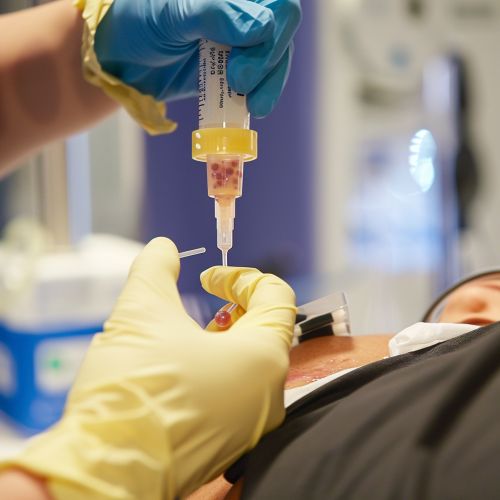Graft-versus-host disease
Introduction
Graft-versus-host disease (GVHD) is a medical complication that can occur after a hematopoietic stem cell transplantation (HSCT), where the donated bone marrow or peripheral blood stem cells view the recipient's body as foreign and attack the host's tissues. This condition is a significant cause of morbidity and mortality post-transplantation and can manifest in acute or chronic forms.
Pathophysiology
GVHD arises when donor T cells recognize the recipient's antigens as foreign and initiate an immune response. The pathogenesis of GVHD involves a complex interplay of cytokines, antigen-presenting cells, and effector T cells. The process can be divided into three phases:
1. **Initiation Phase**: This phase involves the activation of host antigen-presenting cells (APCs) due to the conditioning regimen (chemotherapy or radiation) that the recipient undergoes before transplantation. This regimen causes tissue damage, leading to the release of pro-inflammatory cytokines such as tumor necrosis factor-alpha (TNF-α) and interleukin-1 (IL-1).
2. **Donor T Cell Activation**: In this phase, donor T cells recognize host antigens presented by APCs. This recognition is facilitated by major histocompatibility complex (MHC) molecules. The interaction between donor T cells and host APCs leads to the proliferation and differentiation of donor T cells into effector cells.
3. **Effector Phase**: The effector T cells migrate to target tissues, releasing cytotoxic molecules and cytokines that cause tissue damage. The primary target organs include the skin, liver, and gastrointestinal tract.
Clinical Manifestations
GVHD can be classified into acute and chronic forms based on the timing of onset and clinical features.
Acute GVHD
Acute GVHD typically occurs within the first 100 days post-transplantation and primarily affects the skin, liver, and gastrointestinal tract.
- **Skin**: The earliest and most common manifestation is a maculopapular rash, which may progress to generalized erythroderma or blistering.
- **Liver**: Liver involvement is characterized by elevated bilirubin levels, alkaline phosphatase, and transaminases, leading to jaundice.
- **Gastrointestinal Tract**: Symptoms include nausea, vomiting, diarrhea, and abdominal pain. Severe cases can result in gastrointestinal bleeding and malabsorption.
Chronic GVHD
Chronic GVHD can occur any time after the first 100 days post-transplantation and can affect multiple organs, resembling autoimmune disorders.
- **Skin**: Chronic GVHD of the skin can present as lichen planus-like eruptions, scleroderma-like changes, or poikiloderma.
- **Liver**: Chronic liver involvement leads to cholestatic liver disease with elevated liver enzymes and bilirubin.
- **Eyes**: Ocular manifestations include keratoconjunctivitis sicca (dry eye syndrome) and scleritis.
- **Lungs**: Pulmonary involvement can lead to bronchiolitis obliterans, causing progressive airflow obstruction.
- **Gastrointestinal Tract**: Chronic GVHD can cause esophageal strictures, malabsorption, and weight loss.
Diagnosis
The diagnosis of GVHD is primarily clinical, supported by histopathological findings from biopsies of affected tissues. Diagnostic criteria include:
1. **Clinical Presentation**: Symptoms and signs consistent with GVHD in the skin, liver, or gastrointestinal tract. 2. **Histopathology**: Biopsy of affected tissues showing characteristic features such as apoptosis in the skin, bile duct damage in the liver, and crypt cell apoptosis in the gastrointestinal tract. 3. **Laboratory Tests**: Elevated liver enzymes, bilirubin, and inflammatory markers.
Risk Factors
Several factors increase the risk of developing GVHD, including:
- **HLA Mismatch**: The degree of human leukocyte antigen (HLA) mismatch between donor and recipient significantly impacts the risk of GVHD.
- **Donor Age**: Older donor age is associated with a higher risk of GVHD.
- **Gender Disparity**: Female donors to male recipients have an increased risk due to the presence of minor histocompatibility antigens.
- **Conditioning Regimen**: The intensity of the conditioning regimen can influence the risk of GVHD.
- **Source of Stem Cells**: Peripheral blood stem cells are associated with a higher risk of GVHD compared to bone marrow stem cells.
Prevention
Preventive strategies for GVHD include:
- **HLA Matching**: Ensuring the highest possible degree of HLA matching between donor and recipient.
- **T Cell Depletion**: Techniques such as ex vivo T cell depletion or in vivo use of antithymocyte globulin (ATG) to reduce the number of donor T cells.
- **Immunosuppressive Therapy**: Prophylactic use of immunosuppressive agents such as cyclosporine, tacrolimus, and methotrexate.
Treatment
The management of GVHD involves a combination of immunosuppressive therapies and supportive care.
Acute GVHD
- **First-Line Therapy**: High-dose corticosteroids such as prednisone or methylprednisolone are the mainstay of treatment.
- **Second-Line Therapy**: For steroid-refractory cases, options include mycophenolate mofetil, sirolimus, and infliximab.
Chronic GVHD
- **First-Line Therapy**: Corticosteroids combined with calcineurin inhibitors such as cyclosporine or tacrolimus.
- **Second-Line Therapy**: Agents such as rituximab, imatinib, and extracorporeal photopheresis.
Prognosis
The prognosis of GVHD varies depending on the severity and response to treatment. Acute GVHD has a higher mortality rate, particularly in severe cases. Chronic GVHD can lead to long-term complications and reduced quality of life. Early diagnosis and prompt treatment are crucial for improving outcomes.
Research and Future Directions
Ongoing research aims to better understand the mechanisms of GVHD and develop novel therapeutic approaches. Areas of interest include:
- **Biomarkers**: Identifying biomarkers for early detection and monitoring of GVHD.
- **Cellular Therapies**: Exploring the use of regulatory T cells and mesenchymal stem cells to modulate the immune response.
- **Targeted Therapies**: Developing targeted therapies that specifically inhibit pathways involved in GVHD pathogenesis.
See Also


